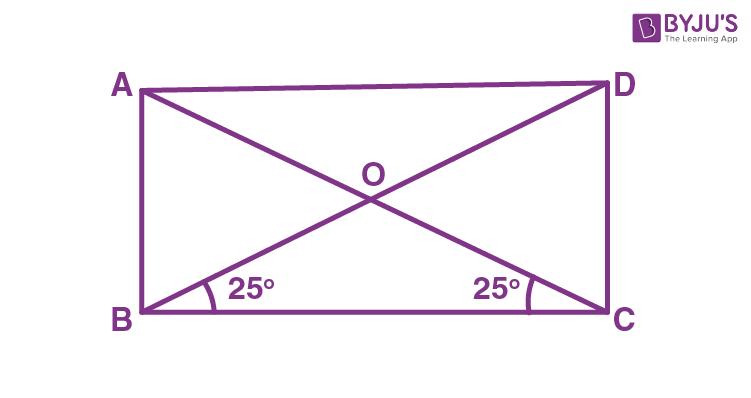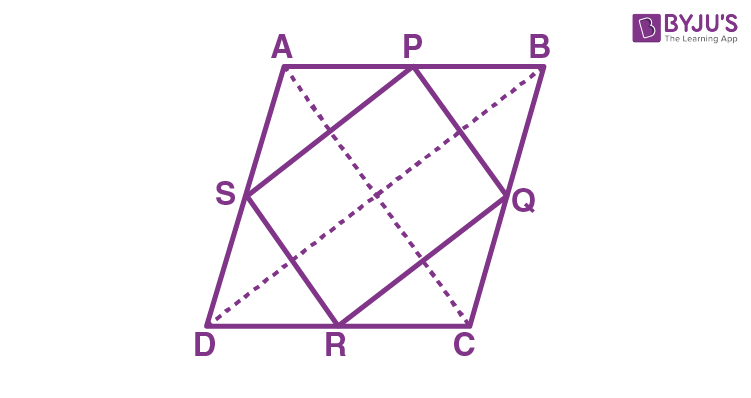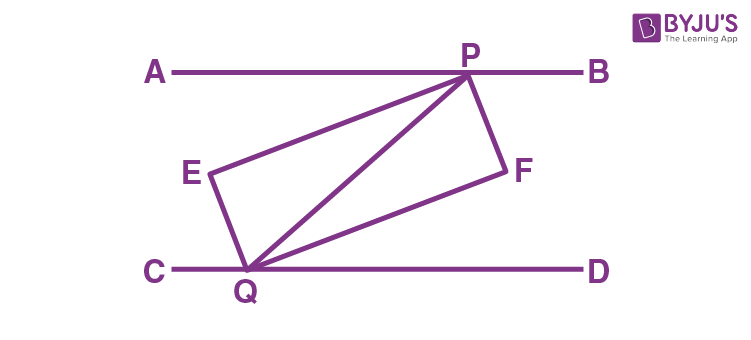Class 9 Maths Chapter 8 Quadrilaterals MCQs
Class 9 Maths Chapter 8 Quadrilaterals MCQs are available here with answers, online. The questions are prepared, as per the CBSE syllabus and NCERT curriculum. Students can prepare for exams with the help of these objective questions to score good marks. The answers are available with detailed explanations. Get chapter-wise MCQs at BYJU’S and also check Important Questions for Class 9 Maths.
MCQs on Class 9 Maths Chapter 8 Quadrilaterals
Solve the questions provided below with four multiple options and choose the correct one.
1) The quadrilateral whose all its sides are equal and angles are equal to 90 degrees, it is called:
a. Rectangle
b. Square
c. Kite
d. Parallelogram
Answer: b
2) The sum of all the angles of a quadrilateral is equal to:
a. 180°
b. 270°
c. 360°
d. 90°
Answer: c
3) A trapezium has:
a. One pair of opposite sides parallel
b. Two pairs of opposite sides parallel to each other
c. All its sides are equal
d. All angles are equal
Answer: a
Explanation: A trapezium has only one pair of opposite sides parallel to each other, and the other two sides are non-parallel.
4) A rhombus can be a:
a. Parallelogram
b. Trapezium
c. Kite
d. Square
Answer: d
5) A diagonal of a parallelogram divides it into two congruent:
a. Square
b. Parallelogram
c. Triangles
d. Rectangle
Answer: c
6) In a parallelogram, opposite angles are:
a. Equal
b. Unequal
c. Cannot be determined
d. None of the above
Answer: a
7) The diagonals of a parallelogram:
a. Equal
b. Unequal
c. Bisect each other
d. Have no relation
Answer: c
8) Each angle of the rectangle is:
a. More than 90°
b. Less than 90°
c. Equal to 90°
d. Equal to 45°
Answer: c
Explanation: Let ABCD is a rectangle, and ∠A = 90°
AD || BC and AB is a transversal
∠ A + ∠ B = 180° (Interior angles on the same side of the transversal)
∠ A = 90°
So, ∠ B = 180° – ∠ A = 180° – 90° = 90°
Now, ∠ C = ∠ A and ∠ D = ∠ B (Opposite angles of the parallelogram)
So, ∠ C = 90° and ∠ D = 90°
Hence all sides are equals to 90°.
9) The angles of a quadrilateral are in the ratio 4: 5: 10: 11. The angles are:
a. 36°, 60°, 108°, 156°
b. 48°, 60°, 120°, 132°
c. 52°, 60°, 122°, 126°
d. 60°, 60°, 120°, 120°
Answer: b
Explanation: Let x be the common angle among all the four angles of a quadrilateral.
As per angle sum property, we know:
4x+5x+10x+11x = 360°
30x = 360°
x = 12°
Hence, angles are
4x = 4 (12) = 48°
5x = 5 (12) = 60°
10x = 10 (12) = 120°
11x = 11 (12) = 132°
10) If ABCD is a trapezium in which AB || CD and AD = BC, then:
a. ∠A = ∠B
b. ∠A > ∠B
c. ∠A < ∠B
d. None of the above
Answer: a
Explanation: Draw a line through C parallel to DA intersecting AB produced at E.
CE = AD (Opposite sides)
AD = BC (Given)
BC = CE
⇒ ∠CBE = ∠CEB
also,
∠A + ∠CBE = 180° (Angles on the same side of transversal and ∠CBE = ∠CEB)
∠B + ∠CBE = 180° ( As Linear pair)
⇒ ∠A = ∠B
11) Which of the following is not true for a parallelogram?
(a) Opposite sides are equal
(b) Opposite angles are equal
(c) Opposite angles are bisected by the diagonals
(d) Diagonals bisect each other.
Answer: c
Explanation: Opposite angles are bisected by the diagonals is not true for a parallelogram. Whereas opposite sides are equal, opposite angles are equals, diagonals bisect each other are the properties of a parallelogram.
12) Three angles of a quadrilateral are 75º, 90º and 75º. The fourth angle is
(a) 90º
(b) 95º
(c) 105º
(d) 120º
Answer: d
Explanation: We know that the sum of angles of a quadrilateral is 360º.
Let the unknown angle be x.
Therefore, 75º+90º+75º+x = 360º
x = 360º – 240º = 120º.
13) ABCD is a rhombus such that ∠ACB = 40º. Then ∠ADB is
(a) 40º
(b) 45º
(c) 50º
(d) 60º
Answer: c
Explanation: We know that the diagonals of the rhombus bisect each other perpendicularly.

By using the alternate interior angles, and angle sum property of triangle, we can say:
From the triangle, BOC,
∠BOC + ∠OCB + ∠OBC = 180º
(where ∠BOC= 90º, ∠OCB = 40º)
90º+40º+ ∠OBC = 180º
∠OBC = 180º – 130º
∠OBC = 50º
∠OBC =∠DBC
Now, by using alternate angles, we can say
∠ADB = 50º
14) The quadrilateral formed by joining the mid-points of the sides of a quadrilateral PQRS, taken in order, is a rhombus, if
(a) PQRS is a rhombus
(b) PQRS is a parallelogram
(c) Diagonals of PQRS are perpendicular
(d) Diagonals of PQRS are equal.
Answer: d
Explanation: The quadrilateral formed by joining the mid-points of the sides of a quadrilateral PQRS, taken in order, is a rhombus if the diagonals of PQRS are equal.
15) A diagonal of a rectangle is inclined to one side of the rectangle at 25º. The acute angle between the diagonals is
(a) 25º
(b) 40º
(c) 50º
(d) 55º
Answer: c
Explanation: Consider the rectangle ABCD

In a triangle BOC,
∠OBC = ∠OCB (Opposite angles of isosceles triangle)
Therefore, ∠OBC + ∠OCB+∠BOC = 180º
25º+25º + ∠BOC = 180º
∠BOC = 180º- 50º
∠BOC = 130º.
By using the linear pair,
∠AOB + ∠BOC = 180º
∠AOB = 180º – 130º
∠AOB= 50º
Hence, the acute angle between the diagonals is 50º.
16) If angles A, B, C and D of the quadrilateral ABCD, taken in order, are in the ratio 3:7:6:4, then ABCD is a
(a) Kite
(b) Rhombus
(c) Parallelogram
(d) Trapezium
Answer: d
Explanation:
Given that, the angles A, B, C and D of a quadrilateral are in the ratio 3:7:6:4.
We know that A+B+C+D = 360º
Hence, now we can assume, 3k+7k+6k+4k= 360º
20k = 360º
k=18º
Therefore, A = 3k = 54º
B= 7k = 126º
C = 6k = 108º
D = 4k= 72º
If we draw the quadrilateral with these angles, we get a trapezium.
17) The quadrilateral formed by joining the mid-points of the sides of a quadrilateral PQRS, taken in order, is a rectangle, if
(a) PQRS is a rectangle
(b) PQRS is a parallelogram
(c) Diagonals of PQRS are perpendicular
(d) Diagonals of PQRS are equal
Answer: c
Explanation: The quadrilateral formed by joining the mid-points of the sides of a quadrilateral PQRS, taken in order, is a rectangle, if the diagonals of PQRS are perpendicular.
18) The figure obtained by joining the mid-points of the sides of a rhombus, taken in order, is
(a) a square
(b) a rhombus
(c) a rectangle
(d) any parallelogram
Answer: c
Explanation: Let ABCD be a rhombus. P, Q, R, S be the midpoint of the sides AB, BC, CD and DA. If we join the midpoints, we will get the shape rectangle.

19) If APB and CQD are two parallel lines, then the bisectors of the angles APQ, BPQ, CQP and PQD form
(a) Square
(b) Rectangle
(c) Rhombus
(d) any other parallelogram
Answer: b
Explanation:

Hence, the bisectors of the angles APQ, BPQ, CQP and PQD form the shape rectangle.
20) Which of the following is not a quadrilateral?
(a) Kite
(b) Square
(c) Triangle
(d) Rhombus
Answer: c
Explanation: square, kite and rhombus are quadrilaterals as it has four sides. Whereas a triangle is not a quadrilateral as it has only three sides.
Stay tuned with BYJU’S – The Learning App and download the app today to get more class-wise concepts.